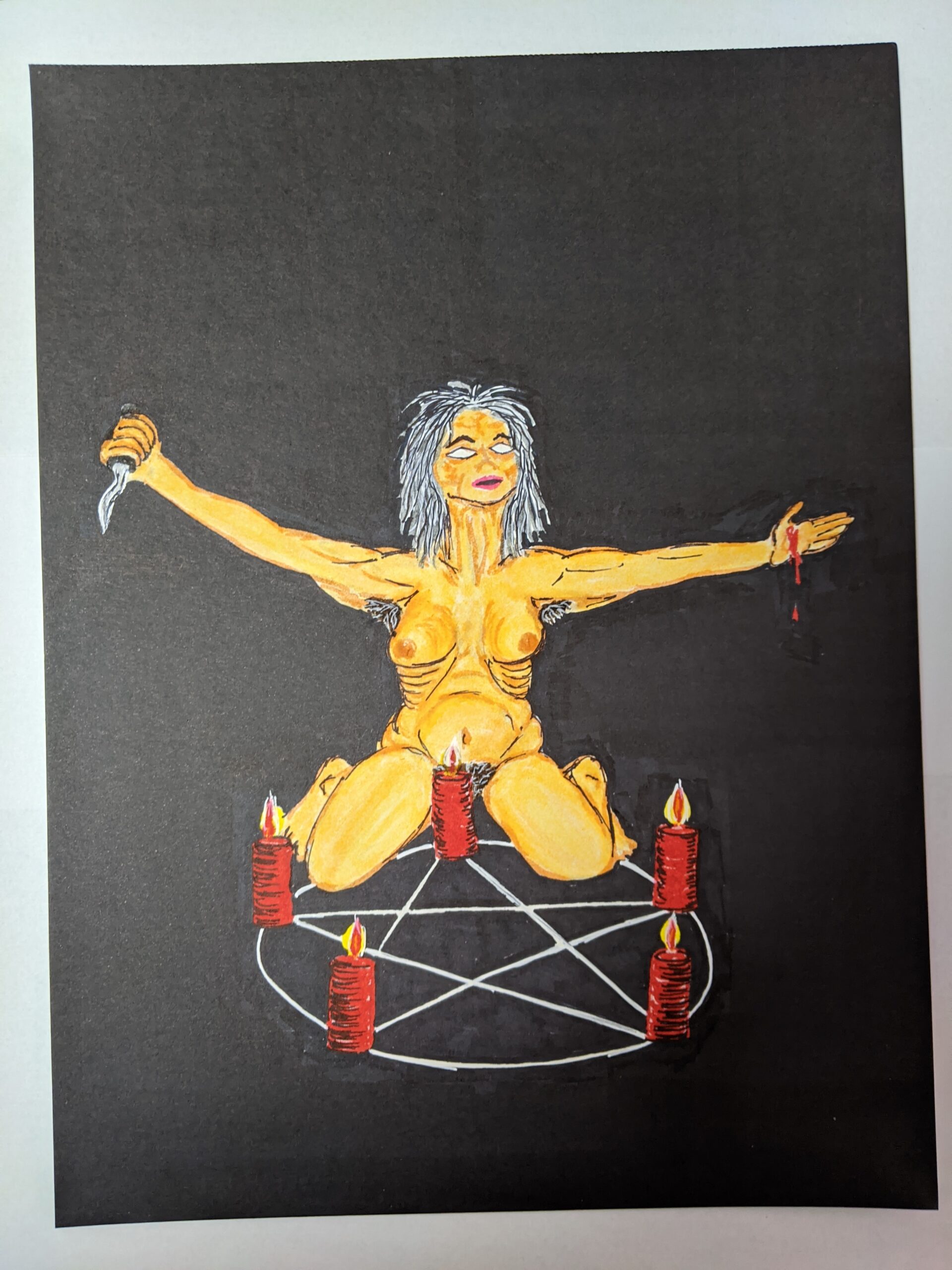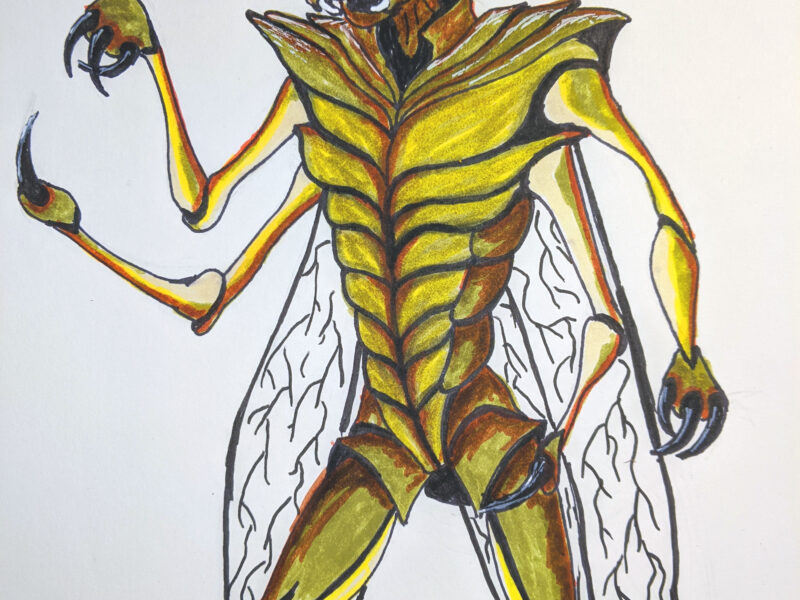Its not the hat that makes her a witch
This marker drawing is another one I did for a Mabs Halloween Prompt. The subject was obviously a witch.
I went this direction with it because I am a grumpy old fuck who hates the cartoon vision of a witch as it is portrayed in almost everything.
On the other hand. The idea that women are banging demons to curry favor and get special powers? Now that is some scary , horror whore type shit that I can get behind. HAHAHA.
Anyway, I figured sketch a glass eyed witch summoning her power source would be fun.
I still like the drawing now, even though I see some pretty big flaws in it. Meh. Its art, and it is fun. I hope you enjoy too.
Here is a bunch of things that brobot thinks about the image and witchery in art in general.
The provided image depicts a dramatic artistic portrayal of a witch or sorceress figure engaged in ritualistic activity. Let’s first break down what’s shown and then place it within the historical and cultural context of witches.
Analysis of the Image
In the drawing, a female figure is illustrated kneeling, nude, with arms outstretched. She holds a dagger in one hand, while the other hand appears injured, blood dripping—a suggestion of ritual sacrifice or blood magic. She sits within a pentagram surrounded by candles, reinforcing imagery commonly associated with witchcraft in modern popular culture. Her eyes glow blankly, signifying supernatural or trance-like involvement, and her pose projects power, defiance, and ritualistic fervor.
This portrayal immediately calls to mind modern pop culture imagery of witches, emphasizing dark, occult, and dramatic elements.
Witches in Recorded History
Historically, the idea of witches or practitioners of magic dates back to ancient civilizations:
- Ancient History:
Witchcraft or “magic” rituals date back to early recorded human history, from the priestesses of Ancient Egypt, who practiced rituals invoking protection and healing, to shamans across many ancient cultures. - Medieval and Early Modern Europe:
The strongest historical association with witches arose in medieval Europe (15th to 18th centuries). Accusations of witchcraft were prevalent, often fueled by paranoia, religious hysteria, and societal fears. Those accused—often women marginalized due to poverty, age, independence, or healing skills—faced severe punishment, torture, and execution (famously via witch burnings or hangings). The Salem Witch Trials (1692-1693) in colonial America are among the most infamous examples. - Alleged Realistic Activities:
Many “witches” were, in reality, healers, midwives, herbalists, or simply individuals who challenged societal norms. These practices involved medicinal plants, folk remedies, and basic natural wisdom. Accusations often came from misunderstandings or fears surrounding disease outbreaks, crop failures, or unexplained events.
Witches in Pop Culture
The witch has become an iconic pop-culture archetype, evolving considerably over the years:
- Early Portrayals:
Fairy tales and folklore portray witches as villainous, evil old women (e.g., Hansel and Gretel). Shakespeare’s Macbeth (early 1600s) presents witches as eerie prophets who cause chaos and manipulation. - 20th Century and Hollywood:
Hollywood amplified the dramatic, sinister stereotype. The Wicked Witch from The Wizard of Oz (1939) and films like Rosemary’s Baby (1968) reinforced an association with dark forces and occult rituals. - Modern Depictions:
More recently, witches have been portrayed positively, symbolizing empowerment, nature-worship, feminism, or rebellion against oppressive institutions. Media examples include Practical Magic (1998), Charmed (1998–2006), American Horror Story: Coven (2013–2014), and Sabrina the Teenage Witch (both the comedic 90s series and darker Netflix reboot). Witchcraft is now often shown as empowering, spiritual, connected to nature, and protective rather than inherently malicious.
Overly Dramatic Artistic Portrayals
Artistic portrayals historically lean toward the dramatic and sensational. Artists of the Romantic and Gothic eras in particular created highly theatrical images:
- Romantic/Gothic Period Art (18th-19th century):
Artists like Francisco Goya famously depicted witches as grotesque, shadowy figures involved in sinister rituals. Paintings often showed exaggerated gatherings, dances with demons, and dramatic scenes filled with supernatural imagery. Such portrayals intensified public fascination, fear, and misunderstanding of real practices. - Modern Artistic Portrayals:
Contemporary art often employs exaggerated imagery—such as the one analyzed here—to evoke emotion, shock, or fascination, reinforcing witchcraft’s darker stereotypes. Art typically draws from sensationalized elements—pentagrams, candles, blood sacrifice—as visual shorthand for drama, darkness, rebellion, or mystery.
A Realistic View of Alleged Witchcraft Activities
Realistically, alleged witchcraft historically involved:
- Herbalism and Healing:
Common folk medicine, natural remedies, and midwifery. Knowledge of plant medicine was crucial and misunderstood as magic. - Nature Worship and Animism:
Many accused “witches” held reverence for nature, seasons, and natural cycles—seen today in Neo-Pagan practices such as Wicca, emphasizing balance, harmony, and respect for the environment. - Ritual and Symbolism:
Ritual practices often involved symbolic gestures rather than literal sacrifices. Elements like pentagrams historically symbolized harmony of elements (earth, air, fire, water, spirit), not necessarily evil intent.
Conclusion
The image provided clearly aligns with the dramatic, sensationalized portrayal common in popular media and modern imagination. Historically, however, witches were often misunderstood figures—healers, herbalists, and victims of fear and prejudice rather than malevolent actors. Modern portrayals have increasingly reclaimed the witch as an empowering symbol, reflecting a more balanced view of historical realities and cultural imagination.



